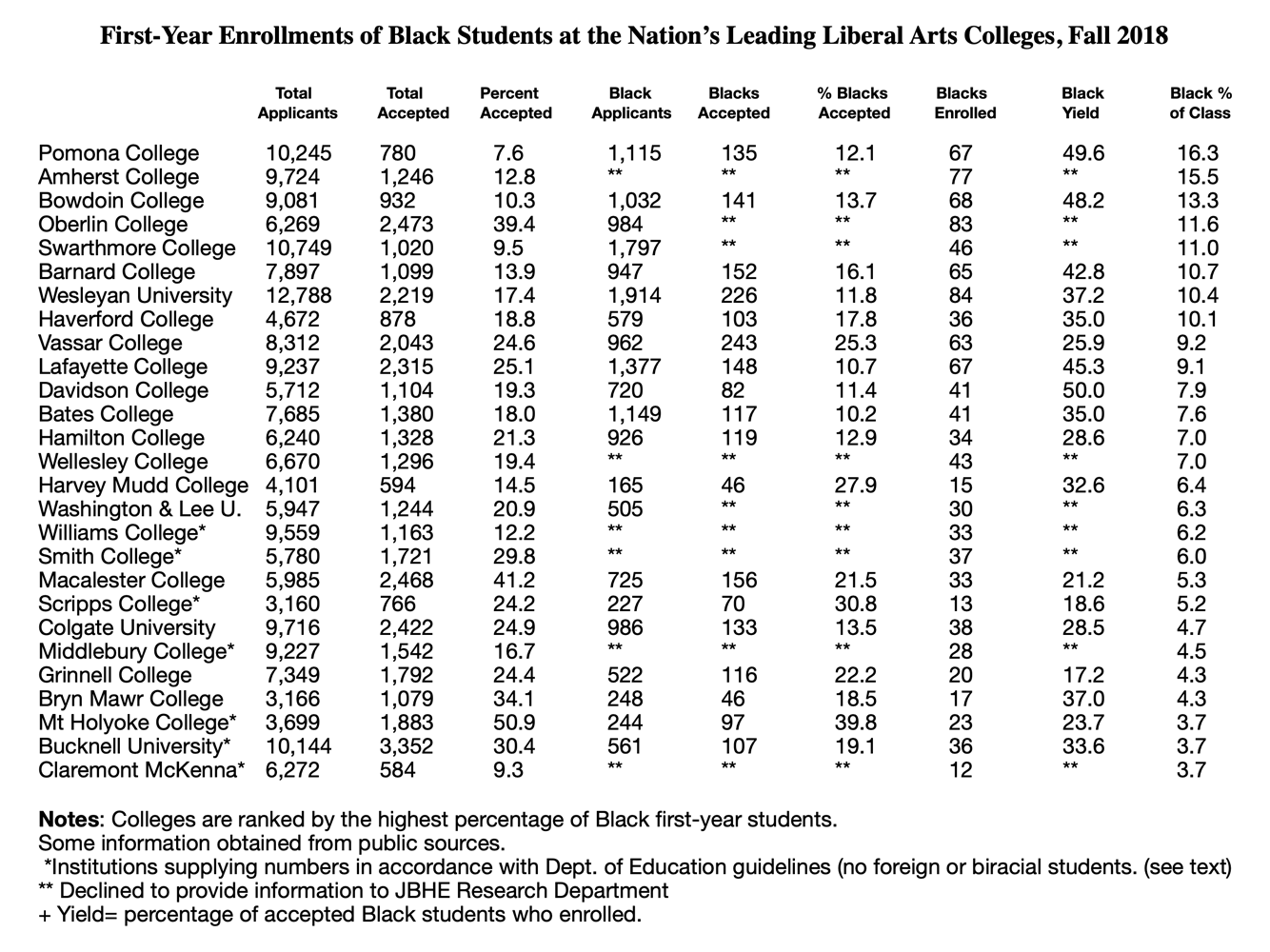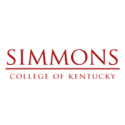![]() For the past 25 years, JBHE has collected Black student admissions data from the highest-ranked liberal arts colleges. Over this long period, there have been 11 years when Amherst College in Massachusetts reported the highest percentage of Black first-year students. On six occasions, Wesleyan University in Middletown, Connecticut, had enrolled the highest percentage of Black first-year students.
For the past 25 years, JBHE has collected Black student admissions data from the highest-ranked liberal arts colleges. Over this long period, there have been 11 years when Amherst College in Massachusetts reported the highest percentage of Black first-year students. On six occasions, Wesleyan University in Middletown, Connecticut, had enrolled the highest percentage of Black first-year students.
Two years ago, for the first time in the history of our survey, Pomona College in Claremont, California, had the highest percentage of Black students in the entering classes at the nation’s leading liberal arts colleges. There were 65 Black first-year students at Pomona College that year. They made up 15.8 percent of the entering class. Last year, Pomona dropped to fourth place with an entering class that was 12.6 percent Black. This year, once again Pomona sits atop our rankings. Pomona has 67 Black first-year students, up from 52 last year. Blacks are 16.3 percent of the first-year class.

Last year, Amherst College finished atop our survey for the 11th time and the fourth time in the last five years. This year, there are 77 Black first-year students at Amherst, only one less than a year ago. Blacks make up make up 15.5 percent of the entering class. Three years ago, there were 87 Black first-year students at Amherst. They made up a whopping 18.2 percent of the first-year class. This was largest percentage of Black first-year students at any of the high-ranking liberal arts colleges in the 25 years that JBHE has conducted this survey.
Bowdoin College in Brunswick, Maine, ranks third in this year’s survey with an entering class that is 13.3 percent Black. A year ago, Bowdoin ranked second with an entering class that was 14.3 percent Black. At that time, a Bowdoin spokesperson told JBHE that “diverse perspectives, backgrounds, and experiences are essential components of a liberal arts education. So, we have broadened our recruitment efforts to different areas of the country. We have also eliminated a barrier for some students by doing away with our application fee for those applying for financial aid and for first-generation college students.”
Oberlin College in Ohio has a long history of supporting African American higher education and served as a stop on the Underground Railroad in the pre-Civil War era. In recent years, Oberlin has often ranked in the middle of the pack on the JBHE survey of Black first-year students. But this year, Oberlin has moved up to fourth place with an entering class that is 11.6 percent Black. The number of Black first-year students at Obelrlin is up by more than 45 percent from a year ago.
Swarthmore College in Pennsylvania ranks fifth in our survey this year. For the previous two years, Swarthmore has held the third position. There are 46 Black first-year students at the college this year, making up 11.6 percent of the entering class. Three years ago, Swarthmore ranked 14th in our survey of leading liberal arts colleges in the percentage of Black students in the entering class. That year, Blacks were 8.1 percent of the first-year class.
Barnard College in New York City has an entering class than is 10.7 percent Black. This places the women’s college in sixth place in our survey, up six spots from a year ago.
Wesleyan University, which as stated, has led our rankings on six occasions including six years ago, ranks seventh in this year’s survey. Blacks are 10.4 percent of the first-year class at Wesleyan. Six years ago when Wesleyan led the rankings, Blacks were 11.3 percent of the entering class.
Haverford College in Pennsylvania, ranking in eighth place, was the only other high-ranking liberal arts college reporting an entering class that is more than 10 percent Black.
Vassar College in Poughkeepsie, New York, and Lafayette College in Easton, Pennsylvania, both reported entering classes that were more than 9 percent Black. Lafayette College showed a major increase from 45 Black first-year students in 2017 to 67 this academic year.
Williams College has been a consistent performer is our survey over the past quarter century. Three years ago, Williams ranked third with an entering class that was 13.1 percent Black. This year, a college spokesperson told JBHE that “we are unable to provide this information and will be unable to provide it going forward.” No information was provided on why the decision not to participate was made. Through public data, we were able to determine that under U.S. Department of Education classifications, Blacks make up 6.2 percent of the entering students at Williams College this year.
Here is one very encouraging statistic: In 2009, only three of the nation’s high-ranking liberal arts colleges had entering classes that were at least 10 percent Black. This year there are eight.
A Note on Methodology
Before we continue with the results, it is important to mention how the U.S. Department of Education collects data on the race of undergraduates. Before a change was made several years ago, students who reported more than one race (including African American) were included in the figures for Black students. This is no longer the case. Thus, students who self-identify as biracial or multiracial with some level of African heritage are no longer classified as Black by the Department of Education.
JBHE surveys have always asked respondents to include all students who self-identify as having African American or African heritage including those who are actually from Africa. JBHE has always maintained that biracial, multiracial, and Black students from Africa add to the diversity of a college campus. And including these students in our figures offers college-bound Black students a better idea of what they can expect at a given college or university. In order that we can compare our current data to past JBHE surveys we have continued to asked colleges and universities to include all students who identify themselves as having African American or African heritage.
Some of our responding liberal arts chose to report results that correspond with official Department of Education figures. They are indicated on the main table with an asterisk. It should be noted that if biracial, multiracial, and Black foreign students were included in the Black percentage of students in the first-year classes at these institutions, the overall percentage of Black students would undoubtedly be higher.
Black Student Acceptance Rates
Six years ago, for the first time in the history of the JBHE survey of liberal arts colleges, more responding colleges had a lower acceptance rate for Black students than their overall acceptance rate compared to the number of colleges that had a Black acceptance rate that was higher than their overall rate. This was true again in 2013, 2014, 2015, 2016, and 2017. This makes the seventh year in a row when more liberal arts colleges that chose to divulge this data showed a lower acceptance rate for Black students than the acceptance rate for students overall. In fact, the trend has accelerated. This year, among the reporting institutions, only six high-ranking liberal arts colleges had a Black student acceptance rate that was higher than for the overall applicant pool. Four years ago there were nine. Also, there are very few colleges that chose to report Black student acceptance rate data where there is a large racial gap in acceptance rates. Typically, the margin is very small.
There are some exceptions. For example, at Macalester College in Minnesota, 41.2 percent of all students were accepted but only 21.5 percent of Black students were admitted. In contrast, Harvey Mudd College accepted only 14.5 percent of all applicants. But the acceptance rate for Black applicants was 27.9 percent.
We must also point out that there appears to be a greater reluctance to divulge information about Black student acceptance rates. The recent litigation involving the admissions practices of Harvard University concerning Asian American students appears to have struck a nerve in higher education circles. Colleges and universities increasingly seem to want to hold their cards close to their vests and not add fuel to efforts to challenge affirmative action admissions policies.
While no firm conclusions can be made, the fact that for the past seven years there are now more colleges with overall acceptance rates that are higher than Black acceptance rates, causes one to wonder if there has been some curtailment in colleges’ consideration of race in admissions decisions. Or it may be that the colleges that have a much higher acceptance rate for Black students than they do for the applicant pool as a whole, are unwilling to publicize this information in fear of litigation or do not wish to anger some contributing alumni who are not in favor of race-sensitive admissions,
Student yield is calculated by seeing what percentage of accepted students decided to enroll. Among the leading liberal arts colleges who supplied this information to JBHE, the highest Black student yield was at Davidson College in North Carolina. There, 50 percent of accepted Black students decided to enroll. Pomona College ranked second with a Black student yield of 49.6 percent. A year ago, Black student yield at Pomona was under 40 percent. The jump in yield contributed to Pomona moving back into the top spot in our survey this year. Among the institutions reporting yield data, Bowdoin College, Lafayette College and Barnard College were the only other leading liberal arts colleges that had a Black student yield of more than 40 percent.











Black enrollment rates in relation to population ratios are significant for judging claims of racial discrimination.Are not graduation rates equally important?
Blacks enrolling in to a selective colleges have much higher graduation rates. Read McPherson’s ‘CROSSING THE FINISH LINE.”
The graduation rate is equally as important. Our ability to attract the brightest is a major factor but there must be vehicles for mobility and success in place to somewhat ensure an increase in the graduation rate.
Our high school assist in preparing our students for life after 12th grade but we are also guilty of extreme nurture or should I say, holding the student’s hand and feeding them information to a degree. This is not to say high school does not teach and guide students to thing analytically and problem solve. The bottom line is students must graduate. Yes, additional students are entering higher education.